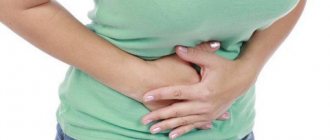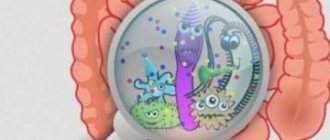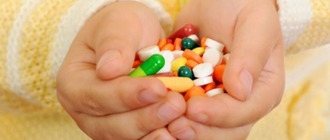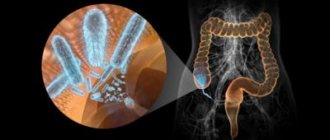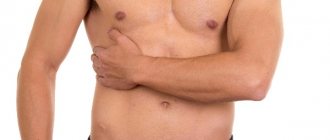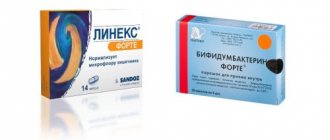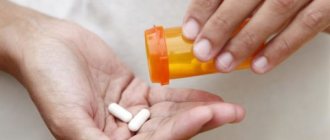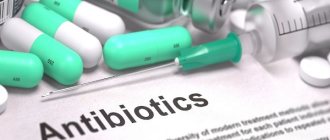Negative effects of antibiotics on the stomach
The human body is not sterile. There is a community of microorganisms that perform important and beneficial functions for humans, one of which is participation in the creation of a microbial association that does not allow pathogenic microflora to colonize and multiply in the body. Antibiotics do not have a selective effect, and their use destroys both pathogenic bacteria and beneficial microorganisms.
Due to the acidic environment, the stomach contains a limited number of colonies of microorganisms. The most acid-resistant bacteria for the stomach are:
- lactobacilli;
- gram-positive: micrococci, streptococci, bifidobacteria;
- spore-forming microbes;
- enterococci;
- mold fungi.
The most dangerous microbe leading to the formation of peptic ulcers is the bacterium Helicobacter pylori.
Antibiotics damage the gastric mucosa, inhibit local microflora, and affect one of the mucosal protection factors - prostaglandins. These are lipid mediators that are involved in regulating the synthesis of mucopolysaccharides and hydrochloric acid.
What causes abdominal pain
The gastrointestinal tract works as follows: in the stomach after eating food, it is broken down through the juice it produces and continues on its way to the intestines, where it is absorbed. Antibiotics are mixed in the body along the same path, but begin to be absorbed at the first stage, so they must be consumed only after a person has eaten. This avoids stomach pain.
Stomach upset after taking antibiotics is common. After all, it is necessary to take probiotics along with such medications. If the latter are not drunk, the medicine kills the microflora, which is expressed as dysbacteriosis. Associated symptoms will be: heaviness and pain in the stomach, nausea.
What should you do if you need to take antibiotics because there is no other way to cure the disease? Follow a number of recommendations:
- Be sure to eat before taking your medicine, but do not overeat.
- When taking the drug, eat foods that can coat the gastric organ: puree soup, jelly, slimy porridge. The following are harmful to the stomach when treated with antibiotics: coffee, tea, marinade, spicy dishes, alcoholic drinks.
- It is better not to take medications in tablet form. Intramuscular or intravenous administration is much safer for microflora. The medicine immediately enters the bloodstream, bypassing the gastrointestinal tract, causing virtually no side effects.
- Take your medications with only half a glass of filtered water. Juices, milk, tea, etc. are not suitable.
- The antibiotic also kills beneficial bacteria, so you also need to take probiotics at the same time so that the microflora returns to normal.
Does the body suffer greatly when treated with such drugs? Ask your doctor if you can replace it so as not to harm your health so much.
Symptoms of dysbiosis
Stomach dysbiosis is combined with dysbiosis of the entire digestive tract, so the clinical picture includes symptoms of damage to the stomach and intestines. Initially, signs of gastritis appear: abdominal discomfort after eating, belching. Without treatment, the condition worsens: stomach pain, nausea, vomiting, and bloating occur. Stool disorder is manifested by alternating diarrhea and constipation.
Symptoms of gastroesophageal disease (GERD) may develop when stomach contents back up into the lower esophagus. Clinically, this is manifested by painful heartburn and hiccups. When the body weakens, a dangerous fungal infection of the stomach develops - candidiasis.
Treatment methods
If spasms and pain appear after taking antibacterial drugs, probiotics, antispasmodics, and antidiarrheals are prescribed.
Medicines to restore microflora
First of all, the following drugs are prescribed to stop diarrhea in case of gastric dysbiosis (abdominal pain is one of its symptoms): Enterol, Enterosgel, Smecta.
To restore disturbed intestinal microflora, probiotics and prebiotics are prescribed.
This group of drugs includes Hilak, Bifiform, Acipol:
- Hilak is a drug that normalizes intestinal flora. It affects the digestive system and metabolism. With the help of these drops, diarrhea is stopped, inflammation of the stomach and intestinal mucosa is relieved. The drug stimulates the growth of the epithelium of the intestinal wall, restoring its integrity.
- Bifiform is a drug that normalizes intestinal flora during antibiotic therapy. Contains lactic acid bacteria that can restore intestinal microflora.
- Acipol is used for dysbacteriosis, including after antibiotic therapy. Contains lactobacilli, kefir fungus, which is able to restore intestinal microflora.
To relieve stomach cramps, the doctor may prescribe special drugs Mebeverine, Dicetel.
Folk remedies
To avoid stomach pain, you should drink warm chamomile tea.
1 tbsp. l. dry chamomile flowers are poured with a glass of boiling water and left for half an hour. Once the tea has cooled to a comfortable temperature, you can drink it 30 minutes before meals.
In this recipe, chamomile acts as a natural antispasmodic.
Calendula tincture is also good for relieving stomach cramps. It is sold in every pharmacy and is inexpensive. 1 tbsp. l. tinctures are diluted in half a glass of warm water, take the solution three times a day an hour before meals.
It is important that the tea must be made fresh every time.
To soothe an irritated stomach, relieve inflammation of the mucous membrane, and restore microflora, traditional medicine recommends consuming fermented milk products:
- kefir;
- fermented baked milk;
- yogurt;
- fermented milk whey;
- curdled milk;
- acidophilus.
Drink them in the morning on an empty stomach and in the evening before bed. These products contain lactic acid bacteria .
With regular consumption, the intestinal microflora will be restored, your health will improve after taking antibiotics, your digestion will improve, and cramps and stomach pain will go away.
Diet and nutrition for recovery
During antibiotic treatment, it is good to include fermented milk products, sauerkraut, fruits, vegetables, and berries in the patient’s diet. They are also called natural probiotics.
Contain a small amount of probiotics and help maintain healthy intestinal microflora:
- chicory;
- garlic;
- bananas;
- onion;
- cheese;
- pickled cucumbers.
It is good to eat foods rich in fiber during the treatment period - beets, fresh and sauerkraut, broccoli, lentils, and nuts. They cleanse the intestines well, and the nutrients contained in them are absorbed almost completely.
During the period of antibacterial therapy, vitamin deficiency develops in adults and especially in children. It is recommended to support the body at this time and start taking vitamin complexes after a course of antibiotics.
You cannot combine antibacterial drugs and grapefruit and orange juices. They neutralize the effect of drugs, and treatment may not be effective.
Also exclude all heavy and harmful foods from the diet:
- everything fried and fatty;
- sausages;
- marinades;
- confectionery and bakery products.
Reason: they put additional stress on the liver and digestive system, which becomes vulnerable when taking medications.
It is important to drink at least 2-3 liters of water per day during the treatment period . Almost all medications are eliminated through the kidneys, and water allows you to speed up this process and cleanse the body.
Diagnostics
Are used:
- FGDS - fibrogastroduodenoscopy is performed to assess the condition of the gastric mucosa, detect signs of gastritis or ulcerative defects.
- Blood chemistry. Protein fractions, serum electrolytes, cholesterol and lipoproteins, and liver enzymes are determined.
- Stool analysis for dysbacteriosis is carried out in two ways. With the bacteriological method, biological material (stool) is inoculated onto nutrient media. Based on the results of colony growth, the species and quantitative composition of microorganisms is determined. Biochemical - gas-liquid chromatographic analysis of stool - more informative and accurate.
- Coprogram. Assessment of the digestive capacity of the digestive system (presence of fibers, enzymes, dyes, bacteria).
- Tests for the presence of the bacterium Helicobacter pylori in the stomach.
Stomach recovery after antibiotics
Maintain a healthy lifestyle
Giving up bad habits is the first thing a person should take care of. Cigarette smoke can severely irritate the gastric mucosa, and drinking alcohol after taking antibiotics is strictly prohibited. This is due to the fact that the drugs reduce the protective functions of the liver; the organ will not be able to quickly and efficiently process harmful substances that enter there. At the same time, it is advisable to devote time to physical exercise, which helps improve immunity, and it is important to provide the body with good rest.
Medications
Therapy for dysbacteriosis solves the problems of restoring normal microflora of the digestive tract, improving digestion processes, and relieving pathological symptoms. Probiotics are used for this purpose.
Probiotics are a class of living microorganisms that live in a healthy human gastrointestinal tract and have a positive effect on metabolic processes in the body. Lactobacterin contains acidophilic bacteria.
Bifiform – contains two types of lactic acid bacteria. The medicine prevents the reproduction and spread of pathogenic microbes in the body. It has a good therapeutic effect in antibiotic-associated diarrhea.
Inexpensive analogues of Bifiform:
- Bifidumbacterin forte . The price starts from 150 rubles for 10 capsules of the drug.
- Acipol - capsules contain live acidophilic lactobacilli. The cost of 30 capsules is 285 rubles.
- Linex is classified as a universal probiotic; it contains the full set of bacteria necessary for normal digestion (lactobacillus, bifidobacteria and streptococci). The drug maintains and regulates the balance of microbial flora.
Depending on age, probiotics are prescribed in the form of drops, capsules, tablets, and powders.
For adults, probiotics for the stomach enclosed in capsules (Linex, Bifiform) are considered the best. In this dosage form, all the properties of living microorganisms are preserved.
- Linex;
- Lactofiltrum;
- Probifor;
- Bifidumbacterin.
During pregnancy and lactation, it is allowed to prescribe probiotics, as they do not have a negative effect on the development of the fetus.
According to user reviews, the use of probiotics in the complex treatment of dysbiosis significantly reduces the severity of symptoms (diarrhea, bloating, heartburn and nausea).
For young children, the medicine is prescribed in the form of a solution and dosed in drops.
Probiotics for babies:
- Rotabiotic baby;
- Bifiform Baby;
- Hilak Forte - in addition to the treatment of dysbiosis, it is prescribed for poisoning and candidiasis.
Drug therapy aimed at restoring the gastric microflora is prescribed by the doctor. Self-medication without taking into account quantitative and qualitative changes in the microflora of the stomach can lead to an intensification of the pathological process and the development of complications.
Recovery after antibiotics is important for health!
The discovery of antibiotics became a milestone in the development of not only medicine, but also society as a whole. Such effective drugs, of course, naturally have side effects. However, the benefits of antibacterial agents are so pronounced that their use, despite the high prevalence of side effects, will not stop. Among the side effects of almost all antibiotics, the most common is indigestion in the form of stool upset and the occurrence of anbitiotic-associated diarrhea. Moreover, recently the incidence of antibiotic-associated diarrhea has increased. The modern lifestyle of a modern person, the lack of time to visit a doctor and self-medication with antibiotics, the availability and over-the-counter sale of antibacterial agents in pharmacies have led to a high prevalence of digestive problems and diarrhea during or after taking antibiotics. The incidence of antibiotic-associated diarrhea (AAD), depending on the class of drugs used and the effect of predisposing factors, can vary from 3 to 29%. Up to 40% of all cases of antibiotic-associated diarrhea are associated with Clostridium difficile infection. Colitis caused by C. difficile is considered the most common cause of diarrhea,
Reaction of intestinal microflora to antibiotics.
The development of AAD is associated with impaired functioning of the intestinal microflora. In parallel with the destruction of pathogenic microorganisms, antibacterial agents negatively affect the microflora of the intestine, genitourinary system, etc. As a result, the number of “useful” bacteria that help us absorb nutrients, participate in the production of vitamins, determine the normal functioning of the intestines, and regulate the frequency of stools decreases. Beneficial bacteria are bifidobacteria and lactobacilli, which die when exposed to antibiotics, and their number sharply decreases. Instead of bifido- and lactoflora, opportunistic microbes begin to grow in the intestines, leading to digestive disorders, causing diarrhea, abdominal pain and other symptoms.
As a result of a decrease in the number of bifidobacteria and lactobacilli in the intestine during antibacterial therapy, the metabolic function of the intestinal microflora is disrupted. Impaired digestion and absorption of carbohydrates and fiber itself leads to osmotic secretion of water and osmotic diarrhea. Also, bifidobacteria and lactobacilli break down fiber into short-chain fatty acids (SCFA), which provide intestinal cells with energy carriers and improve the trophism of the mucous membrane. A decrease in the synthesis of SCFA leads to dystrophic changes in the integumentary epithelium, the permeability of the intestinal barrier to antigens of food microbial origin increases, and the absorption of water and electrolytes is impaired. Due to changes in the composition of normal intestinal microflora, the deconjugation of bile acids is disrupted. An excess of primary bile acids, which are powerful stimulants of intestinal secretion, leads to secretory diarrhea. Violation of the protective function of intestinal microflora under the influence of antibiotics leads to a decrease in colonization resistance, that is, the ability of normal intestinal microflora to effectively suppress the growth of pathogenic microorganisms is reduced. With a decrease in the number of anaerobes of normal intestinal microflora, competition with pathogens for receptors of the intestinal mucosa weakens, local immunity decreases - the production of lysozyme and immunoglobulin A. In the created favorable conditions, the progressive reproduction and growth of pathogenic flora, in particular Clostridium difficile, begins. The pathological effect of pathogenic flora and microbial toxins leads to damage to the mucous membrane of the colon, inflammation, diarrhea and colitis.
Restoration of microflora after taking antibiotics.
You can restore the functioning of the gastrointestinal tract after taking antibiotics or prevent complications of antibiotic therapy by normalizing the intestinal microflora. It is possible to maintain and restore your own individual intestinal microflora and populate the intestines with microorganisms representing normal intestinal microflora using special means - probiotics. Probiotics contain live microorganisms that have a therapeutic effect; they populate the intestines, fight opportunistic flora and improve the functioning of the digestive system.
Probiotic microorganisms help restore normal functioning of the gastrointestinal tract and improve digestion. In addition, probiotics perform other functions that are normally inherent in normal intestinal microflora: they strengthen the body’s immune defense, produce vitamins B, K, etc.
Probiotics contain industrial probiotic strains of microorganisms (bifidobacteria, lactobacilli, etc.), and each culture of microorganisms must be present in quantities of at least 1x10 8 CFU. The effectiveness and safety of using probiotics has been proven and is beyond doubt.
The presence of an individual composition, concentration ratio and strains of certain bifido- and lacto- and other bacteria-representatives of the normal intestinal microflora is absolutely necessary with a competent approach to improving the functioning of the gastrointestinal tract.
Among the probiotic preparations, we can highlight FLORASAN preparations, which are created for each specific patient, taking into account the cause that caused the disruption of intestinal function. It is FLORSAN A that is used to restore impaired functions of the gastrointestinal tract and normalize the intestinal microflora in persons with acute stool disorders when treated with antibacterial agents. The largest Russian scientists in the field of gastroenterology participated in the creation of FLORASAN probiotics. Clinical trials of the drug FLORSAN were and are being carried out in the leading gastroenterological clinic of Russia under the leadership of the chief gastroenterologist of the Russian Federation, academician of the Russian Academy of Medical Sciences V.T. Ivashkin in the clinic of propaedeutics of internal diseases, gastroenterology and hepatology named after V.Kh. Vasilenko First Moscow State Medical University named after I.M. Sechenov.
The composition of Florasan A contains a sufficient amount of not only bifidobacteria and lactobacilli (Bifidobacterium longum, not less than 1x109 CFU, Bifidobacterium bifidum not less than 1x109 CFU, Lactobacillus rhamnosus not less than 1x109 CFU), but also Saccharomyces cerevisiae lysate (0.5 g). It is medicinal Saccharomycetes that have proven an undoubted effect in the treatment of antibiotic-associated intestinal lesions according to the results of clinical studies. Thus, Florasan A has a therapeutic effect, destroying the growth and reproduction of pathogenic microflora, but also restores the composition of the microflora by populating the gastrointestinal tract and genitourinary system with bifidobacteria and lactobacilli.
Diet
Diet, along with medications, is a prerequisite for the treatment of dysbiosis. With dysbiosis, there is a gap in the balance between beneficial and pathogenic microbes, the process of digestion and absorption of nutrients is disrupted, so food during this period should be mechanically and chemically gentle. In the diet it is necessary to reduce the amount of sugar and foods that cause increased gas formation: grapes, black bread, fresh milk.
Recommended:
- cooking method: boiling, stewing, baking, steaming;
- dairy products;
- puree soups, pureed boiled vegetables, water porridge;
- dishes made from minced lean meat: chicken breast, turkey, rabbit;
- drinks: jelly, compotes of dried fruits and fresh sweet berries.
Prohibited:
- fried, spicy, smoked dishes;
- baked goods, confectionery, cakes, sweets);
- marinades, canned food;
- drinks: alcohol, coffee, strong tea, sparkling water;
- fatty meats and fish.
Natural probiotics are found in foods:
- cheese;
- kefir;
- yogurt;
- buttermilk;
- legumes (peas, beans);
- sauerkraut;
- garlic, onion;
- bananas.
Regular inclusion of these products in the diet will help normalize the biocenosis of the stomach and intestines.
The duration of the diet is at least 3 months.
Prebiotics to restore the stomach and intestines
To reduce the risk of side effects from the digestive tract, antibiotic treatment must be combined with bifid medications. They differ not only in dosage form and cost, but also in active ingredients, so it is better to choose the appropriate drug with your doctor. The most effective and frequently prescribed drugs in this group are listed in the table below.
Table. Prebiotics for stomach restoration.
| Drug name | What bacteria are included | How to use |
| "Yogulact" | Lyophilisate of live bifidobacteria | 1-2 capsules 3 times a day with meals or before meals. Duration of treatment is 1-2 months. |
| "Biovestin" | Bifidobacterium adolescentis | 12 ml per day 30 minutes before meals, first diluted with cold water or milk. Duration of treatment – 4 weeks (in individual cases – up to 3 months). |
| "Lakto-filtrum" | Lactulose. Hydrolytic lignin | 2-3 tablets 3 times a day an hour before meals (pre-grind). The duration of treatment should not exceed 3 weeks. |
| "Rioflora" | Live lyophilized bifidobacteria. Inulin. Fructooligosaccharides | 2 capsules 2 times a day on an empty stomach for two weeks. |
| "Normobakt" | Live bifidobacteria | 1 sachet 1-2 times a day for 10 days. |
Sasha "Normobakt"
Note! Some prebiotics contain lactose (mostly in monohydrate form). This must be taken into account when prescribing, since such drugs cannot be given to persons with lactose intolerance and lactase deficiency.
Probiotics and prebiotics in the gut
ethnoscience
Traditional medicine methods are used to restore the stomach after antibiotics as an adjuvant. During the rehabilitation period, decoctions and infusions of herbs that have an enveloping effect are useful: flax, Lyubka bifolia, spotted orchis. These herbs create a protective layer on the surface of the gastric mucosa that protects it from the irritating effects of gastric juice.
Herbs with anti-inflammatory effects: chamomile and calendula inflorescences, St. John's wort, yarrow, yellow gentian, calamus root.
To normalize upset stools during diarrhea, infusions from medicinal raw materials are prepared:
- oak bark;
- bergenia root;
- burnet root;
- bird cherry berries;
- Potentilla erecta.
For constipation use:
- fennel;
- anise;
- caraway;
- dill;
- buckthorn;
- zhoster.
How to restore your stomach
Few people nowadays can boast of ideal functioning of the gastrointestinal tract. Diseases of the stomach with damage to its mucous membrane are very common. Many people prefer not to seek medical help and treat themselves (on the Internet, on the advice of authoritative friends). So can you do this yourself or do you need to consult a specialist? This depends on the cause of the pathological process occurring in the stomach, on the severity of the clinical picture (complaints, examination data) and on other factors.
In order for the treatment to bring only benefit, the restoration of the stomach must be carried out according to certain rules. Gastroenterologists advise following them to achieve the best result.
What a person who wants to restore their stomach should remember:
Few people nowadays can boast of ideal functioning of the gastrointestinal tract.
Any therapeutic effect should be discussed with a doctor who is familiar with the patient’s medical history. There are different diseases of the gastrointestinal tract, in one case the use of certain drugs may be allowed, in others they are strictly prohibited.- Throughout therapy and subsequently, you should adhere to a gentle diet. It is necessary to exclude all harmful foods from the diet, replacing them with healthy alternatives.
- It is not recommended to use antibiotics unless there is an obvious need, but if you still have to use them, you should support the microflora of the digestive system with supplements containing bifidobacteria.
- If the condition worsens after therapy, it should be stopped and then consult a doctor again. Strict adherence to all the rules will help to avoid complications that sometimes arise with the wrong approach to healing the gastric mucosa.
Strict adherence to all the rules will help to avoid complications that sometimes arise with the wrong approach to healing the gastric mucosa.
Prevention
You can minimize the harmful effects of antibiotics on the gastric mucosa and microflora by following these rules:
- Never take antibiotics without a doctor's prescription, for example, for acute viral infections.
- Strictly follow the instructions for using the medicine: before or after meals, dose, frequency of administration.
- During antibiotic therapy, adhere to a diet containing substances that protect the walls of the stomach (mucous porridges, jelly, puree soups).
- If the patient has already had manifestations of dysbiosis in the past when taking antibiotics orally, switch to parenteral (intramuscular or intravenous) administration. In this case, the medicine will enter the bloodstream, bypassing the gastrointestinal tract.
- Take the tablets only with cool boiled water. The components of tea, compote, milk react with the active ingredient of the medication.
- During treatment it is unacceptable to drink alcohol.
Diet after antibiotic treatment
The basic principle of nutrition after antibiotic treatment is to enrich the diet with foods containing natural prebiotic cultures and lactic acid bacteria. Dairy products prepared using kefir grain starters do an excellent job for this purpose. This can be fermented baked milk, yogurt, cottage cheese, natural yogurt (without flavorings and dyes - these substances create additional stress on the digestive organs). Particularly useful for people who have stomach pain after taking antibiotics are kefir and acidophylline, a product obtained by fermenting pasteurized cow's milk using live bacteria. To quickly restore your stomach, it is enough to drink 1-2 glasses of kefir a day.
Nutrition after antibiotics
Fresh fruits and vegetables also contain large amounts of prebiotics. It is necessary to choose them “according to the season,” since cucumbers and tomatoes grown in winter in greenhouses contain almost 5 times less vitamins and other useful substances compared to summer vegetables that grow in ground soil. To restore the microflora of the gastrointestinal tract, patients are recommended to include the following vegetables and fruits in their diet for two weeks:
- beets;
- tomatoes;
- garlic;
- bell pepper;
- apples.
Recommended Products
If possible, it is recommended to diversify the menu with berries. The acids contained in blueberries, blueberries, raspberries and other forest and garden berries help improve digestion and stimulate the growth of your own beneficial flora, acting as natural prebiotics. It is useful to include a decoction and infusion of rose hips in the diet every day, but it is contraindicated for people with acute pathologies of the gallbladder or bile ducts, since rose hips have a pronounced choleretic effect.
Rosehip infusion
Important! To cope with stomach pain caused by taking antibiotics, speed up the healing of mucous membranes and normalize the microflora, it is necessary to exclude from the menu any foods that create additional stress on the digestive tract. These are alcoholic drinks, spices, fatty and fried foods, pickled vegetables, canned food, sausages. If possible, you should stop smoking or reduce to a minimum the number of cigarettes you smoke per day.
Advice from a gastroenterologist
The symptoms present in dysbiosis of the digestive tract are nonspecific and occur in many other pathologies.
Restoring the functional ability of the stomach after antibiotic therapy is possible only after a thorough examination and treatment prescribed by a gastroenterologist.
If long-term use of antibacterial drugs, especially broad-spectrum ones, is necessary, probiotic drugs, vitamins and microelements are included in complex therapy
If the first signs of dysbacteriosis occur, follow a diet without substances that irritate the mucous membranes.
Why does pain occur?
Antibiotics are a group of drugs that can destroy pathogenic microorganisms. But in addition to pathogenic microbes, they also kill those bacteria that are beneficial and form the normal microflora necessary for the body.
An imbalance resulting from taking antibacterial drugs can cause much more discomfort than the disease itself that was cured by the antibiotic. Microorganisms living in the digestive tract are responsible for the body's defenses, participate in the digestion process and regulate the functioning of the gastrointestinal tract.
After the normal microflora has been exposed to antibiotics, the following unpleasant symptoms may appear:
- severe spasms of the stomach and intestines;
- persistent feeling of nausea;
- disruption of the normal functioning of the digestive system;
- constipation, etc.
If the patient complains of a stomach ache or other of the above symptoms while taking prescribed medications, the attending physician is obliged to select other antibacterial agents with less possible side effects.
Antibacterial agents are prescribed only by the attending physician
How to take antibiotics correctly
Antibiotic treatment disrupts digestion. What should you do and what rules should you follow when taking medications in order to maintain normal well-being in your stomach? Take your medications correctly:
- Some people say: I take the analogue, it’s cheaper, but the effect is the same. You should not do this if the doctor has prescribed it, you must adhere to his recommendations.
- The antibiotics you take are stored in the refrigerator.
- People often ignore medical advice, saying: I take medications when I have a free minute. Diseases should be treated with an antibiotic strictly according to the allotted time and duration of administration prescribed by the attending physician.
- Read the instructions for the medicine carefully. If she requires you to take pills before meals, take them that way. When instructed to store in a dark place, do not disregard the advice.
- Does your stomach hurt after antibiotics? Perhaps the person washed the product down with milk, which led to a similar reaction. Tetracycline behaves exactly like this in such a situation. Remember that you can only drink water.
- Before prescribing a medicine, the doctor is obliged to ask the patient whether he was treated with antibacterial agents and for how long.

